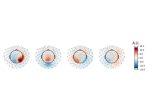mne.decoding.SSD¶
- class mne.decoding.SSD(info, filt_params_signal, filt_params_noise, reg=None, n_components=None, picks=None, sort_by_spectral_ratio=True, return_filtered=False, n_fft=None, cov_method_params=None, rank=None)[source]¶
M/EEG signal decomposition using the Spatio-Spectral Decomposition (SSD).
SSD seeks to maximize the power at a frequency band of interest while simultaneously minimizing it at the flanking (surrounding) frequency bins (considered noise). It extremizes the covariance matrices associated with signal and noise 1.
SSD can either be used as a dimensionality reduction method or a ‘denoised’ low rank factorization method 2.
- Parameters
- info
mne.Info The
mne.Infoobject with information about the sensors and methods of measurement. Must match the input data.- filt_params_signal
dict Filtering for the frequencies of interest.
- filt_params_noise
dict Filtering for the frequencies of non-interest.
- reg
float|str|None(default) Which covariance estimator to use. If not None (same as ‘empirical’), allow regularization for covariance estimation. If float, shrinkage is used (0 <= shrinkage <= 1). For str options, reg will be passed to method to
mne.compute_covariance().- n_components
int|None(defaultNone) The number of components to extract from the signal. If n_components is None, no dimensionality reduction is applied.
- picks
arrayofint|None(defaultNone) The indices of good channels.
- sort_by_spectral_ratiobool (default
False) If set to True, the components are sorted accordingly to the spectral ratio. See Eq. (24) in 1.
- return_filteredbool (default
True) If return_filtered is True, data is bandpassed and projected onto the SSD components.
- n_fft
int(defaultNone) If sort_by_spectral_ratio is set to True, then the SSD sources will be sorted accordingly to their spectral ratio which is calculated based on
mne.time_frequency.psd_array_welch()function. The n_fft parameter set the length of FFT used. Seemne.time_frequency.psd_array_welch()for more information.- cov_method_params
dict|None(defaultNone) As in
mne.decoding.SPoCThe default is None.- rank
None|dict| ‘info’ | ‘full’ As in
mne.decoding.SPoCThis controls the rank computation that can be read from the measurement info or estimated from the data. See Notes ofmne.compute_rank()for details. We recommend to use ‘full’ when working with epoched data.
- info
References
- 1(1,2,3)
Vadim V Nikulin, Guido Nolte, and Gabriel Curio. A novel method for reliable and fast extraction of neuronal EEG/MEG oscillations on the basis of spatio-spectral decomposition. NeuroImage, 55(4):1528–1535, 2011. doi:10.1016/j.neuroimage.2011.01.057.
- 2(1,2)
Stefan Haufe, Sven Dähne, and Vadim V Nikulin. Dimensionality reduction for the analysis of brain oscillations. NeuroImage, 101:583–597, 2014. doi:https://doi.org/10.1016/j.neuroimage.2014.06.073.
- Attributes
Methods
__hash__(/)Return hash(self).
apply(X)Remove selected components from the signal.
fit(X[, y])Estimate the SSD decomposition on raw or epoched data.
fit_transform(X[, y])Fit to data, then transform it.
get_params([deep])Get parameters for this estimator.
get_spectral_ratio(ssd_sources)Get the spectal signal-to-noise ratio for each spatial filter.
Not implemented yet.
set_params(**params)Set the parameters of this estimator.
transform(X)Estimate epochs sources given the SSD filters.
- apply(X)[source]¶
Remove selected components from the signal.
This procedure will reconstruct M/EEG signals from which the dynamics described by the excluded components is subtracted (denoised by low-rank factorization). See 2 for more information.
Note
Unlike in other classes with an apply method, only NumPy arrays are supported (not instances of MNE objects).
- Parameters
- Xarray, shape ([n_epochs, ]n_channels, n_times)
The input data from which to estimate the SSD. Either 2D array obtained from continuous data or 3D array obtained from epoched data.
- Returns
- Xarray, shape ([n_epochs, ]n_channels, n_times)
The processed data.
- fit(X, y=None)[source]¶
Estimate the SSD decomposition on raw or epoched data.
- Parameters
- Returns
- selfinstance of
SSD Returns the modified instance.
- selfinstance of
Examples using
fit:
- fit_transform(X, y=None, **fit_params)[source]¶
Fit to data, then transform it.
Fits transformer to X and y with optional parameters fit_params and returns a transformed version of X.
- get_spectral_ratio(ssd_sources)[source]¶
Get the spectal signal-to-noise ratio for each spatial filter.
Spectral ratio measure for best n_components selection See 1, Eq. (24).
- Parameters
- ssd_sources
array Data projected to SSD space.
- ssd_sources
- Returns
References
Examples using
get_spectral_ratio:
- set_params(**params)[source]¶
Set the parameters of this estimator.
The method works on simple estimators as well as on nested objects (such as pipelines). The latter have parameters of the form
<component>__<parameter>so that it’s possible to update each component of a nested object.- Parameters
- **params
dict Parameters.
- **params
- Returns
- instinstance
The object.
- transform(X)[source]¶
Estimate epochs sources given the SSD filters.
- Parameters
- Xarray, shape ([n_epochs, ]n_channels, n_times)
The input data from which to estimate the SSD. Either 2D array obtained from continuous data or 3D array obtained from epoched data.
- Returns
- X_ssdarray, shape ([n_epochs, ]n_components, n_times)
The processed data.
Examples using
transform:
